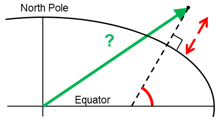5.2.12. nvector.core.n_EB_E2p_EB_E¶
- n_EB_E2p_EB_E(n_EB_E, depth=0, a=6378137, f=0.0033528106647474805, R_Ee=None)[source]¶
Converts n-vector to Cartesian position vector in meters.
- Parameters
- n_EB_E: 3 x n array
n-vector(s) [no unit] of position B, decomposed in E.
- depth: 1 x n array
Depth(s) [m] of system B, relative to the ellipsoid (depth = -height)
- a: real scalar, default WGS-84 ellipsoid.
Semi-major axis of the Earth ellipsoid given in [m].
- f: real scalar, default WGS-84 ellipsoid.
Flattening [no unit] of the Earth ellipsoid. If f==0 then spherical Earth with radius a is used in stead of WGS-84.
- R_Ee3 x 3 array
rotation matrix defining the axes of the coordinate frame E.
- Returns
- p_EB_E: 3 x n array
Cartesian position vector(s) from E to B, decomposed in E.
Notes
The position of B (typically body) relative to E (typically Earth) is given into this function as n-vector, n_EB_E. The function converts to cartesian position vector (“ECEF-vector”), p_EB_E, in meters. The calculation is exact, taking the ellipsity of the Earth into account. It is also non-singular as both n-vector and p-vector are non-singular (except for the center of the Earth). The default ellipsoid model used is WGS-84, but other ellipsoids/spheres might be specified.
Examples
Example 4: “Geodetic latitude to ECEF-vector”

Geodetic latitude, longitude and height are given for position B as latEB, lonEB and hEB, find the ECEF-vector for this position, p_EB_E.
- Solution:
>>> import nvector as nv >>> from nvector import rad >>> wgs84 = dict(a=6378137.0, f=1.0/298.257223563) >>> lat_EB, lon_EB = rad(1), rad(2) >>> h_EB = 3 >>> n_EB_E = nv.lat_lon2n_E(lat_EB, lon_EB) >>> p_EB_E = nv.n_EB_E2p_EB_E(n_EB_E, -h_EB, **wgs84)
>>> 'Ex4: p_EB_E = {} m'.format(p_EB_E.ravel().tolist()) 'Ex4: p_EB_E = [6373290.277218279, 222560.20067473652, 110568.82718178593] m'